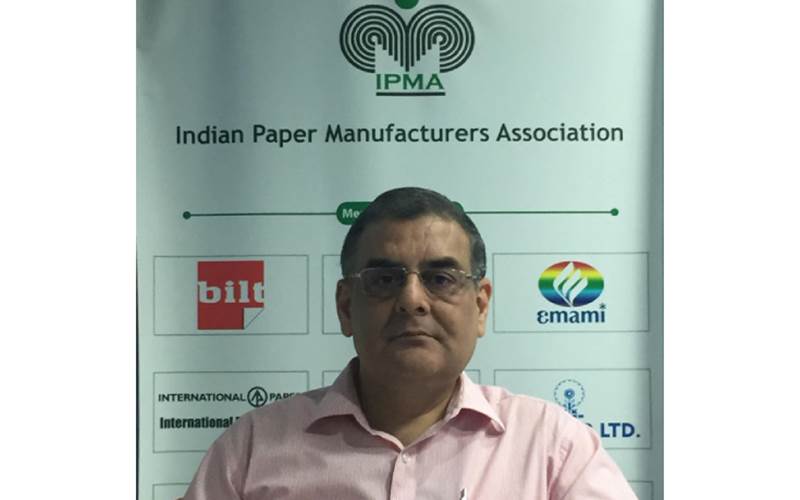Paper industry is reinventing itself: Rohit Pandit
Rohit Pandit, secretary general, Indian Paper Manufacturers Association (IPMA) in an interaction with Aultrin Vijay, offers his views on the state of the paper and paperboard industry in India during the pandemic and sheds light on the myths about paper
13 Oct 2021 | By PrintWeek Team
Aultrin Vijay [AV]: How is the paper industry coping during these turbulent times?
Rohit Pandit [RP]: There is little doubt that the paper industry has been passing through a difficult time during the last year, much like several other industries. As a matter of fact, the paper industry has an extended supply chain ranging from lakhs of farmers involved in agro forestry (for growing wood for the industry) and waste paper collection systems to extensive transportation of raw materials and manufactured products.
AV: What has been the impact of the lockdown in 2020 and the uncertainty since then?
RP: The nationwide lockdown last year led to disruption of both inward and outward supply chains. As the industry was working towards rejuvenating the supply chain and bringing it back to the pre-Covid times, the sporadic lockdowns and mobility restrictions caused by the second wave impacted the fragile recovery.
AV: Which sectors have taken a hit?
RP: The demand for writing and printing paper continues to be severely impacted due to the closure of educational institutes and offices. Newsprint, which was already in the doldrums before the pandemic, has been badly impacted due to a reduction in newspaper circulation, fall in advertising revenue, and more.
The away-from-home demand for tissue has been adversely impacted, with many offices, and commercial establishments closed across the country, with work-from-home continuing even after the lifting of lockdowns. There has been some recovery in a few segments with the easing of restrictions, notably packaging paper and paperboard, with the demand picking-up though it is still below the pre-covid times.
AV: What about exports?
RP: Exports are providing some relief to domestic manufacturers as other countries were not so badly impacted as India during the second wave.
AV: Back on track?
RP: Yes. Despite the threat of the third wave of the pandemic, the consumption and demand for paper is expected to revive fast.
AV: How?
RP: With the revival of economic activity, expected reopening of educational institutions and offices, uptick in tourism, opening up of restaurants and hotels, service industry moving back towards normalcy, and so on.
AV: What are the growth prospects of the paper and paperboard market?
RP: Notwithstanding turbulent times, the growth prospects for paper and paperboard remain intact. We expect the market to grow at 6-7% per annum in the medium term. The per capita consumption of paper in India is a low 15 kgs as compared to the global average of 57 kgs and 200+ kgs in developed nations.
Therefore, growth is bound to take place as the Indian economy grows. Additionally, the demand for paper is growing, as increasingly novel forms for the usage of paper are coming up. On its part, the paper industry has become far more technologically advanced over the last few years.
Debunking the myths
After interacting with many people in the plastic industry, there were three quotes that stood out: “Plastic is portrayed as a villain”; “Paper may be recyclable and sustainable, but the production process is a threat to the ecosystem”; and “Natural habitats are replaced with trees that are meant to produce pulp, thus affecting its natural flora and fauna.” How far are these statements true? Here’s what IPMA’s Rohit Pandit has to say.
The paper production process is not a threat to the ecosystem. The ground realities are very different. The industry has taken significant leaps in the last few years in technological upgradation, process-optimisation and introduction of best practices. The industry has managed to bring down its energy consumption by about 20% in the last five years.
Integrated paper mills in India generate over 40% of the power they use by utilising the biomass from the pulping process. Till a few years ago, the industry used to consume 200 cubic metres of water to produce a tonne of paper. Now, the integrated mills have reduced that to under 50 cubic metres.
Nothing could be further from the truth that natural habitats are being replaced with pulpwood trees. Unfortunately, some myths continue to be perpetuated about paper manufacturing and this is one such. Actually, the wood being used for production of paper is not being procured from forests at all. Paper industry has joined hands with farmers to grow wood in largely degraded land unfit for any other use. Substantial amounts have been spent by the paper industry on plantation R&D, production of high-quality clonal saplings, technical extension services to improve agro/farm forestry services, hand holding of marginal farmers over a gestation period of 4-5 years.
Currently, an estimated 5,00,000 farmers are engaged in growing plantations of Eucalyptus/Subabul in the country. Over 1.2 million hectares of land in the rural areas has been brought under pulpwood plantation by the industry bolstering the green cover and the resultant carbon sequestration, generating rural livelihoods, and supplementing farm incomes.
AV: In what way?
RP: To secure raw material, especially wood, pioneering work has been carried out by the industry over the last three decades. We have produced tree saplings, which are disease and drought-resistant and can be grown in a variety of agro-climatic conditions with a view to aid growth.
AV: You say, aid growth. What is your view on paper demand?
RP: Being environment friendly and sustainable, the demand for paper in most areas will only grow. Modern life is made possible with versatile paper coming to our rescue in a variety of forms. Paperboard and packaging paper is crucial for almost all goods, especially all kinds of essential goods, FMCG, pharmaceuticals, textiles, food products, soaps, milk cartons, hygiene products, and more.
Tissue paper helps in improving hygienic conditions. Literacy levels in India still need to improve significantly, and universal literacy is unthinkable without paper. The paper industry is reinventing itself so as to provide an environment-friendly alternative in different spheres of life.
AV: What are the pain-points in the paper and paperboard space?
RP: The major challenge before the domestic industry is the availability of raw materials in sufficient quantity and at globally competitive prices. India is a fibre deficient country, whether wood or agro residue or recycled fibre/waste paper. Since the raw material is a major cost component of the production of paper, this single factor adversely impacts the cost competitiveness of the Indian industry as compared to other competing countries.
AV: What about cheap imports?
RP: Cheaper imports are coming into India from various countries where raw material supply is assured and that also at relatively low prices, energy costs are much lower, and the like. And this challenge is accentuated by the fact that import duties are either nil or at preferential rates under the free trade agreements (FTAs) and other agreements signed by India with these countries.
AV: Issues such as trade wars, import and anti-dumping duties, and freight costs have been affecting the industry for a while now. There are many who want import duties to be slashed whereas others want it to be increased. Your view...
RP: As mentioned earlier, India’s paper industry suffers from competitive cost issues on account of high raw material, energy and other input costs. Domestic paper manufacturers have capacities and capabilities to meet the demand for all kinds of paper, except in one or two limited areas. The capacity utilisation levels in paper mills are low due to burgeoning imports and the dumping of paper.
AV: How is this being addressed?
RP: In the interest of domestic value addition and generating employment, IPMA has been asking for increasing import duties on finished goods and reviewing the FTAs under which zero duty imports are allowed.
AV: Why is India becoming a paper destination for the international paper mills?
RP: The economic slowdown in developed economies and export-dependent economies and stagnant demand for paper in these countries has led to significant excess capacity of paper and paperboard in these countries. Taking advantage of the nil/low import duty rates in India, these countries find India as an attractive outlet for diverting their excess inventory.
AV: In India, who is feeling the pinch ...
RP: Apart from the overall negative impact of duty-free imports on the domestic paper industry, it is making most small and medium paper mills in India commercially unviable, and also jeopardising the livelihoods of thousands of farmers engaged in agro/farm forestry and supplying wood, the primary raw material, to paper mills.
Due to the pandemic, the global shipping industry got impacted. Currently, there is restricted availability of containers and high ocean freight costs. We expect the situation to get normalised in a few months’ time.
AV: Many companies are eyeing paper-based products as part of their green initiatives. Do you think this is the right time for companies to switch to paper-based products considering the price hikes of paper and paperboard?
RP: Paper is green, and it is never too early to switch to paper-based alternatives for the larger good of the environment. As the production volumes grow, economies of scale come into play, and the cost of production comes down.
Two of the foremost global environment issues are the disposal of single-use plastic and e-waste. Both these issues are addressed to a large extent by the use of paper as an alternative. Paper is one of the most environmentally sustainable products as it is biodegradable, recyclable and is produced from sources, which are renewable and sustainable.
AV: What would be your opinion and suggestion to a friend who is willing to opt for eco-friendly solutions?
RP: Some years back, solar or wind power was much costlier than fossil-fuel based power. But to protect the environment, green energy was incentivised by governments throughout the world. Now, we are in a happy situation that grid parity has been achieved (almost), and the cost of electricity is almost the same across alternate energy sources.
IPMA’s dialogue with the government
IPMA has been continuously taking up with the government to address the raw material issue. India’s paper industry has the potential to enlarge the country’s green cover. IPMA has taken up with the government to make available some part of the country’s degraded forest land and government land for pulpwood (also fuel wood and fodder) plantations under collaborative arrangement, so that the paper industry can access raw material at competitive rates and become globally competitive.
The benefits that will accrue include substantial employment generation in rural areas, savings in foreign exchange outgo, potential for carbon credits, and significant increase in forest cover. We also need to enhance the paper recovery rate in India. Source segregation and collection of post-consumer paper needs aggressive involvement of all stakeholders and civil society.
AV: Innovations pertaining to paper-based packaging have been gaining momentum, especially in the beverages sector. However, little is known about the barrier properties of these proposed alternatives to plastic bottles/packaging. What is the truth?
RP: Plastic is no doubt a very versatile product with barrier properties. Barrier properties are an issue with paper, but rapid strides are being taken in this regard with scientific research and development. Innovative areas and products are being developed for substitution.
AV: Has paper really achieved a barrier property comparable to plastic or is it still plastic doing the hard work?
RP: Low-density polyethene (LDPE) has been used widely with paper to provide liquid barrier properties and heat seal-ability, but to be truly biodegradable and recyclable, the plastic coating needs to be extracted from the paper post-consumption. Bioplastics/biopolymers have been developed in some countries a few years back, which are stated to be fully biodegradable, but are still expensive.
AV: So, it is work in progress?
RP: Finding and perfecting an alternative is a time-consuming process. We have come a long way as far as paper usage is concerned in areas that were unthinkable till recently.
AV: “Plastic vs paper manufacturing; which of them consumes more energy and has a larger carbon footprint?” This is debatable. What would IPMA say?
RP: A broad plastic vs paper debate is an incorrect way of looking at the issue. The problem is mainly with single-use plastic and that also, with its disposal since it is not biodegradable, unlike paper, which is fully biodegradable. India has given an international commitment to ban all single-use plastic by 2022. Both plastic and paper are produced across a wide spectrum of scale, processes and technologies with different energy requirements. Plastic and paper have many advantageous uses, which will continue.
The paper sector has been working hard on reducing specific energy consumption. Under the Perform Achieve Trade (PAT) scheme of the Government, under the National Mission for Enhanced Energy Efficiency (NMEEE), the paper industry has been one of the top-performing sectors and has over-achieved the mandated stiff targets.
AV: Any final thoughts…
RP: The paper industry has been a less celebrated segment of Indian manufacturing. However, the economic and social importance of the paper industry is unique. The estimated turnover of the industry is Rs 70,000 crores (domestic market size of Rs 80,000 crores), and its contribution to the exchequer is around Rs 5,000 crores. The industry provides direct employment to 5-lakh persons, and indirectly to around 1.5- million. The industry supports three vital national objectives of education for all, the greening of India and rural employment.
Rapid fire with Rohit Pandit
Which is your favourite book/s that you’d recommend your friends in the industry to read?
A Fine Balance by Rohinton Mistry, possibly the best English fiction novel written by an Indian. Also, The Great Indian Novel by Shashi Tharoor, a unique take on Mahabharata in contemporary settings.
One thing the pandemic taught you.
To stay in touch with people even without meeting them physically.
Your best moment at IPMA.
First visit to the Paperex exhibition, where I had the opportunity to meet the entire paper industry in India under one roof.
Your favourite paper-based product till date.
Being a voracious reader, without any doubt books.
One piece of advice to the industry.
Watch out and prepare for the evolving global trends in the paper industry of consolidation, rationalisation, substitution, optimisation and regulatory compliance.












 See All
See All